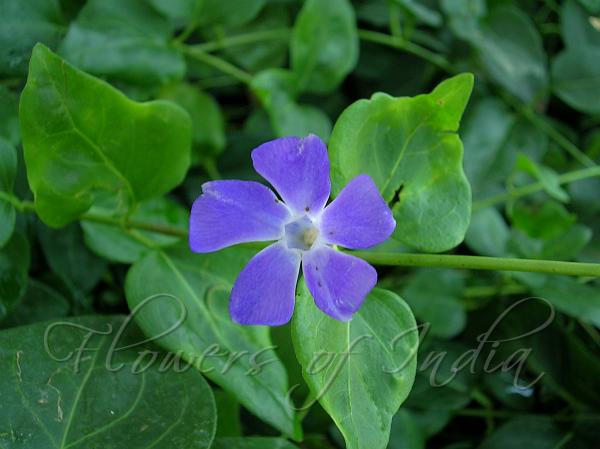|
| Lesser Periwinkle |
|

|

| File size | 686030 |
| Original date | 6/18/05 9:47 AM |
| Resolution | 2048 x 1536 |
| Flash | Flash did not fire, auto |
| Focal length | 8.0mm |
| Exposure time | 1/39s |
| Aperture | 3.2 |
| Focus Distance | |
| Metering Mode | Partial |
| Camera make | NIKON |
| Camera model | E3700 |
| Sensor type |
|
|
|
Photo: Tabish |
Botanical name: Vinca minor Family: Apocynaceae (Oleander family)
Lesser periwinkle is a trailing subshrub, spreading along the ground and
rooting along the stems to form large clonal colonies and occasionally
scrambling up to 40 cm high but never twining or climbing. The
leaves are evergreen, opposite, 2-4.5 cm long and 1-2.5
cm broad, glossy dark green with a leathery texture and an
entire margin. The flowers are solitary in the leaf axils and are
produced mainly from early spring to mid summer but with a few flowers
still produced into the autumn; they are violet-purple (pale purple or
white in some cultivated selections), 2-3 cm diameter, with a
five-lobed flower. The fruit is a pair of follicles 2.5 cm long,
containing numerous seeds. Like many herbs, periwinkle once had ties
with magic and superstition.
Supposedly the herb could ward off evil spirits, and in some places lesser
periwinkle was held that no witch would dare enter a home where it hung at the
entrance. In France the flower of lesser periwinkle is sometimes referred to
as violette des sorciers, or "violet of the sorcerers."
Medicinal uses: The plant is sedative and tonic. It contains the alkaloid 'vincamine',
which is used by the pharmaceutical industry as a cerebral stimulant
and vasodilator. Since the discovery of vincamine in the leaves,
the plant has been used herbally to treat arteriosclerosis and for
dementia due to insufficient blood supply to the brain. The leaves
are bitter, detergent and stomachic. Taken internally, they are used
in the treatment of internal bleeding, heavy menstrual bleeding and
nosebleeds. When crushed and applied to wounds they have astringent
and healing properties. A mouthwash is used to treat gingivitis,
sore throats and mouth ulcers.
The plant is sedative and tonic. It contains the alkaloid 'vincamine',
which is used by the pharmaceutical industry as a cerebral stimulant
and vasodilator. Since the discovery of vincamine in the leaves,
the plant has been used herbally to treat arteriosclerosis and for
dementia due to insufficient blood supply to the brain. The leaves
are bitter, detergent and stomachic. Taken internally, they are used
in the treatment of internal bleeding, heavy menstrual bleeding and
nosebleeds. When crushed and applied to wounds they have astringent
and healing properties. A mouthwash is used to treat gingivitis,
sore throats and mouth ulcers.
Medicinal uses:
 The plant is sedative and tonic. It contains the alkaloid 'vincamine',
which is used by the pharmaceutical industry as a cerebral stimulant
and vasodilator. Since the discovery of vincamine in the leaves,
the plant has been used herbally to treat arteriosclerosis and for
dementia due to insufficient blood supply to the brain. The leaves
are bitter, detergent and stomachic. Taken internally, they are used
in the treatment of internal bleeding, heavy menstrual bleeding and
nosebleeds. When crushed and applied to wounds they have astringent
and healing properties. A mouthwash is used to treat gingivitis,
sore throats and mouth ulcers.
The plant is sedative and tonic. It contains the alkaloid 'vincamine',
which is used by the pharmaceutical industry as a cerebral stimulant
and vasodilator. Since the discovery of vincamine in the leaves,
the plant has been used herbally to treat arteriosclerosis and for
dementia due to insufficient blood supply to the brain. The leaves
are bitter, detergent and stomachic. Taken internally, they are used
in the treatment of internal bleeding, heavy menstrual bleeding and
nosebleeds. When crushed and applied to wounds they have astringent
and healing properties. A mouthwash is used to treat gingivitis,
sore throats and mouth ulcers. | Identification credit: Tabish | Photographed in Nainital |
• Is this flower misidentified? If yes,